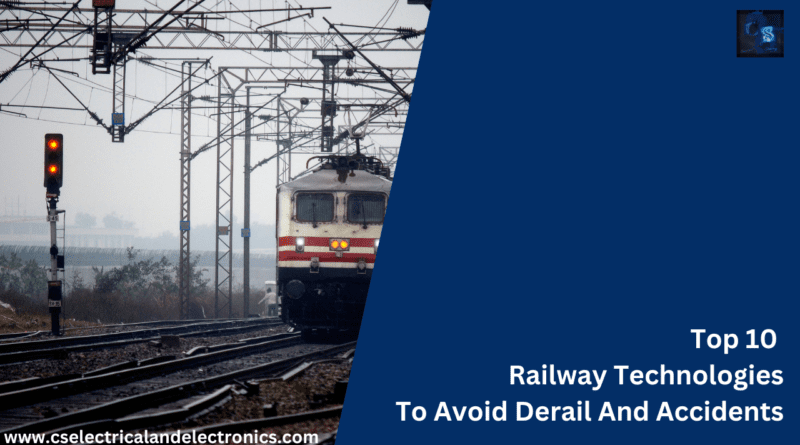Top 10 Railway Technologies To Avoid Derail And Accidents
Hello guys, welcome back to our blog. In this article, we will discuss the top 10 railway technologies to avoid derail and accidents and explain each technology in detail.
If you have any electrical, electronics, and computer science doubts, then ask questions. You can also catch me on Instagram – CS Electrical & Electronics.
Also, read the following:
- Automotive Industry Or VLSI Chip Industry? Which Is Best?
- Mobile App Projects For Computer Science Engineers
- Web Projects For Computer Science Engineers
Railway Technologies To Avoid Derail
When it comes to transferring people and products over long distances, the railway sector is essential. Derailments could cause serious safety risks, monetary losses, and service interruptions, making them one of the main issues in railway operations. Railway technologies have grown to include cutting-edge systems and improvements meant to prevent derailments in an effort to reduce these dangers. This introduction will give a general overview of various important technologies and derailment prevention methods used in the rail sector.
10. Condition-Based Maintenance
By using sensors to continuously check the health of vital train components like wheels, brakes, and bearings, condition-based maintenance transforms the way railway operations are run. The risk of accidents brought on by equipment breakdowns is greatly reduced because of this real-time data collection that enables the early identification of potential issues. Condition-based maintenance, as opposed to conventional time-based or mileage-based maintenance schedules, optimizes resource allocation by concentrating maintenance efforts precisely where they are needed, resulting in cost-effectiveness and increased system reliability.
Railways can improve safety, lower maintenance costs, and lessen service interruptions by introducing condition-based maintenance. It enables operators to make data-driven decisions, anticipate maintenance requirements, and adhere to legal requirements more successfully. By minimizing resource waste and the negative environmental effects of maintenance activities, this method not only increases the overall dependability and safety of railway systems but also supports sustainability initiatives. The use of condition-based maintenance is anticipated to spread throughout railway operations as sensor technology and data analytics continue to progress.
09. Driverless Trains
A promising technology development that has the potential to completely transform rail operations and safety is driverless trains. These autonomous trains offer a number of significant benefits while being in the early phases of development and deployment.
First off, since human variables like fatigue, distraction, and inaccuracy do not affect driverless trains, they may run with a high degree of precision and consistency. This accuracy can result in safer and more effective train operations, lowering the possibility of accidents brought on by human factors.
Second, the ability to watch remotely improves security and quick action. Train performance, track conditions, and possible obstructions can all be continuously monitored by operators and control centers with driverless trains. Remote intervention is an option in the event of an emergency or unforeseen circumstance, enabling prompt and efficient reactions to stop accidents.
The introduction of driverless trains, however, also presents difficulties in terms of technological advancement, infrastructure improvements, and regulatory issues. It is crucial to ensure the dependability and security of autonomous systems as well as the public’s perception and faith in this new technology.
In conclusion, the precise and distant operation of driverless trains has tremendous promise for improving railway safety. These autonomous systems might in fact be extremely important for the development of rail transport in the future as technology advances and legal frameworks change.
08. Collision Avoidance Systems (CAS)
A crucial advancement in railway safety technology is collision avoidance systems (CAS). These systems constantly scan the track surroundings for potential obstacles or other trains using cutting-edge sensors like radar or lasers. An urgent corrective action can be started by a CAS system when it recognizes a potential collision risk. This action might involve warning the train operator or automatically applying the brakes.
Preventing accidents and collisions on the railway network is the main goal of CAS. The real-time monitoring and quick response capabilities offered by CAS greatly increase train operation safety. Derailments, head-on collisions, and other catastrophic events that can cause substantial harm, injuries, or fatalities can be lessened by it.
Modern railway networks are increasingly using CAS systems, which reflects their success in reducing accidents and raising general safety. They demonstrate how cutting-edge technology has been included in rail transit, making it possible for trains to run more safely and dependably despite difficult operational circumstances.
These systems have the potential to significantly improve rail safety and support the industry’s goal of offering safe, effective, and sustainable transportation options as they develop and become more complex. The rail industry’s dedication to advancing safety measures and technology is demonstrated by the widespread deployment of CAS systems.
07. Intelligent Speed Adaptation (ISA)
Modern train safety system called Intelligent Speed Adaptation (ISA) keeps track of and regulates a train’s speed depending on real-time data and track circumstances. The location, speed, and condition of the track are all continuously monitored by this system, which also uses sensors and GPS technology. The objective of ISA is to avoid mishaps, including derailments, by automatically altering the train’s speed to suit the particulars of the track it is using.
Preventing trains from traveling faster than is safe while negotiating curves, crossing bridges, or encountering other track-related elements that could be dangerous if improperly controlled is one of the essential roles of ISA. The risk of derailments and other mishaps brought on by excessive speed is decreased by ISA’s ability to dynamically modify the train’s speed.
Even though ISA is still in the research and testing stage, it has a lot of potential as a useful safety tool for railway operations. ISA systems may become essential elements of railway safety measures as technology develops and regulatory frameworks change, supporting the industry’s continued commitment to improving passenger and crew safety and guaranteeing the dependability of rail transportation networks.
06. Wheel Slide Protection (WSP)
A crucial safety mechanism in railway operations called Wheel Slide Protection (WSP) is intended to stop wheel sliding, which in turn prevents derailments. This device uses sensors and real-time data analysis to identify situations when a train’s wheels can go off the track because of things like slick track conditions or overly aggressive braking. When such an occurrence occurs, WSP reacts quickly by selectively applying the brakes to stop the wheel sliding and preserve traction with the track.
The basic goal of WSP is to guarantee that a train’s wheels stay securely in contact with the rails, regardless of the weather or the need for intense braking. WSP greatly lowers the chance of derailments by avoiding wheel slides, which can happen when wheels lose traction and are unable to navigate curves or maintain stability.
WSP systems have demonstrated their efficacy in raising railway safety, and they are already in use in numerous nations with sizable rail infrastructure. These systems support passenger safety and overall operational dependability in addition to safeguarding the train and its cargo. The extensive use of WSP technology is still an essential part of the railway industry’s commitment to safety, assuring the continuous safe and effective transit of people and goods by rail.
05. Positive Train Control (PTC)
A comprehensive and cutting-edge safety technology called Positive Train Control (PTC) is intended to greatly lower the danger of train accidents on the railway network, particularly in the United States. To accomplish its main goals of preventing train crashes, enforcing speed limits, and guarding against derailments brought on by human error or track-related issues, it integrates numerous components, including GPS, wireless communication, and advanced computer algorithms.
Here are some crucial PTC features:
Collision Avoidance: PTC constantly keeps track of the locations and speeds of the trains moving through the network. It takes rapid action to avert an accident when it notices a potential collision course between two trains, such as applying the brakes or slowing down the implicated trains.
Speed Control: Enforcing speed limitations on different railway track segments is one of PTC’s crucial duties. PTC can automatically intervene to slow down or stop a train if it exceeds the designated speed restriction for a specific location to guarantee safe operations.
Track Condition Monitoring: PTC systems are also capable of keeping an eye on the track’s condition. It can inform the train crew or take appropriate action to prevent derailments if it notices a problem with the track, such as a switch in the wrong place or a damaged rail.
Enhanced Safety: The main objective of PTC is to make rail operations safer. It addresses elements involving people, including human error, which is a major component in train accidents. PTC lessens the possibility of mishaps brought on by operator error by offering real-time monitoring and automated safety mechanisms.
Compliance Requirement: The Rail Safety Improvement Act of 2008 made PTC deployment in the US mandatory. It mandated the adoption and implementation of PTC technology by a set deadline for Class I railways, specific passenger railroads, and rail lines that transport hazardous commodities.
Implementation across the Country: Despite difficulties and setbacks, PTC was scheduled to be completely operational across the Country by the end of 2020. The accomplishment of this objective was an important turning point for American railroad safety.
In conclusion, Positive Train Control (PTC) is an advanced safety system that integrates GPS, radio communication, and computer technology to track and manage train movements with a primary focus on accident avoidance. Its widespread adoption in the US was intended to significantly lower the number of train crashes, derailments, and problems involving excessive speed, making rail travel safer for patrons, employees, and the communities supported by railways.
04. Intelligent Train Control (ITC)
Beyond the capabilities of Positive Train Control (PTC), Intelligent Train Control (ITC) represents a significant development in railway safety technology. Contrary to PTC, which is based on established algorithms and rules, ITC uses artificial intelligence (AI) to make dynamic and data-driven choices about train movements. Despite being in the development stage, ITC has the potential to significantly improve railway safety by providing a more flexible and proactive method of averting derailments and accidents.
ITC’s primary attributes are as follows:
Artificial intelligence: ITC uses AI algorithms to process data from numerous sensors in real-time, as well as information about the track and the specifications of the trains. By having a thorough grasp of the current operating environment, the system is able to make complex decisions.
ITC can respond to unforeseen events and changing environments, in contrast to static rule-based systems. In order to optimize train speed, routing, and braking to avoid accidents in real time, data is continuously analyzed.
Advanced Predictive Analytics: ITC makes use of predictive analytics to anticipate potential safety risks. ITC can avoid derailments and other incidents by spotting possible problems before they become serious.
Increased Autonomy: ITC systems may operate trains with a higher level of autonomy than conventional control systems, which lessens the need for human operators to make choices that are essential for safety.
Potential for Integration: To build a complete and linked safety ecosystem, ITC can be merged with other cutting-edge technologies like remote monitoring, condition-based maintenance, and collision avoidance systems.
The ITC offers difficulties in terms of its development, testing, and regulatory approval even if it has a great deal of potential to revolutionize railway safety. It is crucial to ensure the dependability, security, and safety of AI-based systems, and regulatory organizations must develop criteria and rules for their application.
To sum up, Intelligent Train Control (ITC) is the most advanced railway safety technology to date, utilizing artificial intelligence to offer a more flexible and proactive approach to accident avoidance. As this technology develops and matures, it has the potential to establish new standards for railroad safety by providing a more reliable and effective form of transportation for both people and freight.
03. Automated Warning Systems (AWS)
A vital component of safety for the railway sector, automated warning systems (AWS) are crucial in averting accidents, especially in regions vulnerable to derailments or other dangerous conditions. These systems use cutting-edge sensors to constantly track how close a train is to dangerous areas like tight turns or tricky switch arrangements. AWS immediately issues alarms and, if necessary, automatically starts emergency braking operations when it determines that a train is entering such a region at a dangerous speed.
It is impossible to overestimate how effective AWS has been in preventing derailments and other catastrophic events. AWS serves as a critical defense against human error or unforeseen difficulties on railway tracks by offering real-time notifications and corrective measures. Its extensive use across numerous nations highlights how important it is for improving railway safety, lowering the chance of derailments, and ultimately ensuring the safety of passengers, staff, and freight.
AWS continues to improve the security and dependability of rail transport networks all around the world as a tried-and-true technology. It is an essential tool in the pursuit of safer and more effective railway operations because of its seamless connection with other safety systems and ability to quickly respond to changing operational conditions.
02. Trackside Cameras
Today’s railway safety and monitoring systems must include trackside cameras as a crucial element. These cameras, which are strategically placed along railway lines, continuously monitor and evaluate train movements and track conditions. Their main responsibility is to serve as watchful sentinels, quick to spot any potential problems or irregularities that can cause collisions or derailments.
A trackside camera that notices something suspicious can lead to two very important reactions. First off, it may instantly notify the train crew of the problem and give them important information about it. The crew can avoid potential accidents by acting quickly and appropriately, such as lowering speed or launching emergency procedures, thanks to this rapid communication. Second, trackside cameras can connect with the train’s control systems to immediately apply the brakes in instances of impending danger, significantly boosting the ability to prevent derailments and accidents.
The proliferation of trackside cameras demonstrates a shared commitment to railway safety. These surveillance systems provide a proactive and preventive layer of security, making a substantial contribution to the early detection of hazards and the avoidance of incidents. Trackside cameras are poised to play an ever more significant part in guaranteeing the safety and dependability of rail transport systems around the world as they continue to gain popularity and complexity.
01. Rail Condition Monitoring Systems
Rail Condition Monitoring Systems are a crucial development in rail maintenance and safety. These systems carefully measure and evaluate the state of the railway rails using a variety of sensors. They are also capable of identifying the presence of cracks, flaws, wear, and other anomalies that could jeopardize the track’s structural integrity. Rail Condition Monitoring Systems provide a proactive method for identifying sections of the track that are at risk of derailment or other safety issues, enabling prompt corrective action. They continuously gather and analyze this data.
The importance of Rail Condition Monitoring Systems rests in their capacity to safeguard the safety of railway operations and avoid accidents. These systems give railway authorities the ability to launch targeted maintenance or repair activities by identifying possible concerns in real time and notifying them, preventing small problems from turning into significant safety risks. These systems are also growing more complex as technology advances, including advanced data analytics, machine learning, and predictive modeling to boost their efficacy and accuracy.
The railway industry’s dedication to efficiency and safety is exemplified by the implementation of Rail Condition Monitoring Systems. In addition to helping to prevent derailments, these systems also help to increase the lifespan of track infrastructure, lower maintenance costs, and ultimately provide passengers and cargo operators with a safer and more dependable mode of transportation as they develop and become more integrated into railway networks around the world.
This was about “Railway Technologies To Avoid Derail“. I hope this article may help you all a lot.
Also, read:
- 10 Tips To Maintain Battery For Long Life, Battery Maintainance
- 10 Tips To Save Electricity Bills, Save Money By Saving Electricity
- 100 (AI) Artificial Intelligence Applications In The Automotive Industry
- 100 + Electrical Engineering Projects For Students, Engineers
- 100+ C Programming Projects With Source Code, Coding Projects Ideas
- 1000+ Control System Quiz, Top MCQ On Control System
- 1000+ Electrical Machines Quiz, Top MCQs On Electrical Machines
- 1000+ Electronics Projects For Engineers, Diploma, MTech Students
Author Profile
- Chetu
- Interest's ~ Engineering | Entrepreneurship | Politics | History | Travelling | Content Writing | Technology | Cooking
Latest entries
 All PostsApril 19, 2024What Is Vector CANoe Tool, Why It Is Used In The Automotive Industry
All PostsApril 19, 2024What Is Vector CANoe Tool, Why It Is Used In The Automotive Industry All PostsApril 13, 2024What Is TCM, Transmission Control Module, Working, Purpose,
All PostsApril 13, 2024What Is TCM, Transmission Control Module, Working, Purpose, All PostsApril 12, 2024Top 100 HiL hardware in loop Interview Questions With Answers For Engineers
All PostsApril 12, 2024Top 100 HiL hardware in loop Interview Questions With Answers For Engineers All PostsMarch 22, 2024Driver Monitoring Systems In Vehicles, Working, Driver Sleepy Alert
All PostsMarch 22, 2024Driver Monitoring Systems In Vehicles, Working, Driver Sleepy Alert








